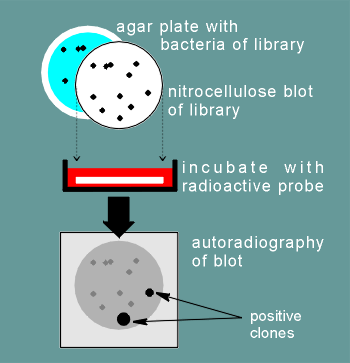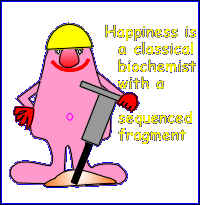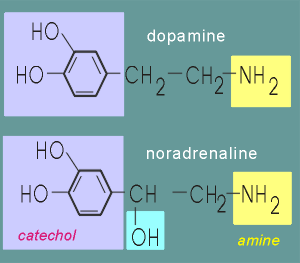 Being the
first to apply a new technique, Numa had a serious problem....how to probe the cDNA
library for the cDNA coding for receptor subunits.
Being the
first to apply a new technique, Numa had a serious problem....how to probe the cDNA
library for the cDNA coding for receptor subunits. Being the
first to apply a new technique, Numa had a serious problem....how to probe the cDNA
library for the cDNA coding for receptor subunits.
Being the
first to apply a new technique, Numa had a serious problem....how to probe the cDNA
library for the cDNA coding for receptor subunits.
Remember, the library would possess bacteria containing cDNA for all the mRNA that the tissue possessed at the time of extraction.
This could involve thousands of mRNA and thus thousands of different bacteria of which only a few contain the desired cDNA.
He had no probe, because there was no pure cDNA for the subunits of the nicotinic receptor with which to make a probe!
Thus he could not determine which of the many thousands of bacterial clones in his cDNA library had the cDNA for the nicotinic receptor subunits.
A real serious problem.
 What Numa did know was the amino acid sequence for small pieces of the
subunits.
What Numa did know was the amino acid sequence for small pieces of the
subunits.
The biochemists may not have been able to sequence the whole receptor, but they had succeeded in sequencing fragments of each subunit.
Thus the solution to the problem....a synthetic nucleotide probe constructed on the basis of the amino acid sequence of a fragment of the receptor.
The probe was made with radioactive nucleotides and thus it was easy to detect with which bacterial clone or clones it bound-to on the nitrocellulose blot of the library.
 In the above
example of a probe, the amino acids of the sequenced fragment are shown as light blue
circles.
In the above
example of a probe, the amino acids of the sequenced fragment are shown as light blue
circles.
One of the amino acids is Arginine (Arg) the codon for which is CGA.
Thus the sequence CGA is built into the probe, so it will make specific binding to the cDNA in the blot of the cDNA library.
In general, sequence information on fragments of ~20 amino acids is sufficient to make a probe (i.e a probe of 60 nucleotides).
In giving the vital sequence information to make a probe, the classical biochemists had made a major contribution to the application of the recombinant approach.
As more and more receptors have become sequenced through the recombinant approach it has become clear that there are large families of receptors, with the receptors within a family having a very similar structure and amino acid sequence.
If one receptor of a family has been sequenced then the cDNA for that receptor can be used to try to probe for other members of that family.
 An
example, the beta-adrenergic receptor, with noradrenaline as endogenous ligand, and the
dopamine D2 receptor, with dopamine as endogenous ligand.
An
example, the beta-adrenergic receptor, with noradrenaline as endogenous ligand, and the
dopamine D2 receptor, with dopamine as endogenous ligand.
The beta-adrenergic receptor was the second receptor to be fully sequenced through the recombinant approach (it is a G-protein linked receptor).
Noradrenaline and dopamine are very similar in structure, they are both catecholamines (figure to left).
It was hypothesized that they would have similar receptors so a beta-adrenergic receptor probe was used to probe a cDNA library produced from a dopamine D2 receptor rich tissue.
The result.....the D2 receptor and two completely new dopamine receptors, the D3 receptor and the D4 receptor!
The approach really works, and has been used successfully time and time again....that is why there is now well over 50 receptors fully sequenced since 1982.
 The human genome project is a National Institutes of Health (NIH) sponsored
project to sequence the entire human genome.
The human genome project is a National Institutes of Health (NIH) sponsored
project to sequence the entire human genome.
This project is delivering so-called "orphan receptors" (particularly of the G-protein associated class of receptors).
One knows that they are a receptor from their general structure and similarity to known receptors.
The only thing one doesn't know is what their ligand is....thus the name "orphan receptors".
It has been estimated that the human genome project should deliver the sequence of several thousand orphan receptors before it is finished.
The real trick is then going to be to find endogenous ligands for the receptors.
While many of the orphan receptors will likely prove to be receptors for known ligands, the search for the orphan receptor ligands will undoubtedly reveal the existence of new neurotransmitters and neuropeptides.